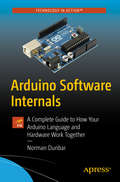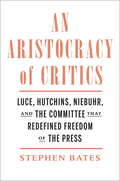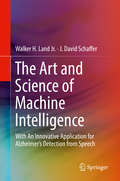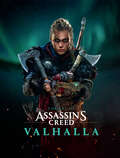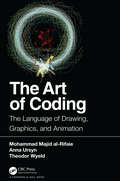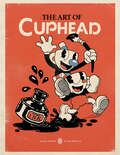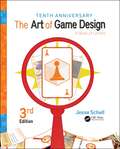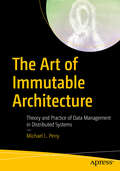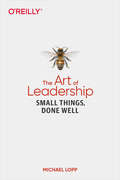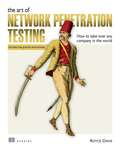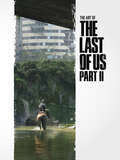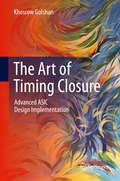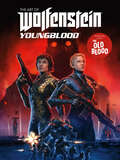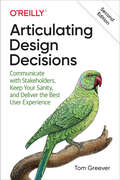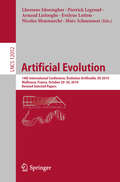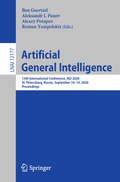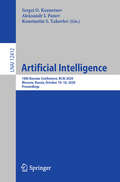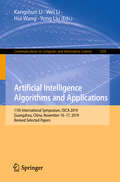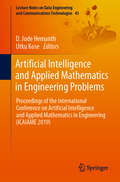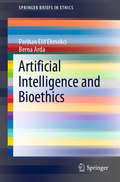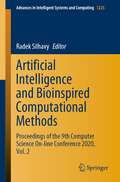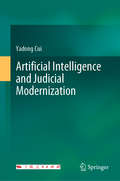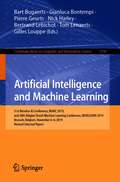- Table View
- List View
Arduino Software Internals: A Complete Guide to How Your Arduino Language and Hardware Work Together
by Norman DunbarIt’s not enough to just build your Arduino projects; it’s time to actually learn how things work! This book will take you through not only how to use the Arduino software and hardware, but more importantly show you how it all works and how the software relates to the hardware.Arduino Software Internals takes a detailed dive into the Arduino environment. We’ll cover the Arduino language, hardware features, and how makers can finally ease themselves away from the hand holding of the Arduino environment and move towards coding in plain AVR C++ and talk to the microcontroller in its native language. What You’ll Learn:How the Arduino Language interfaces with the hardware, as well as how it actually works in C++;How the compilation system works, and how kit can be altered to suit personal requirements;A small amount of AVR Assembly Language;Exactly how to set up and use the various hardware features of the AVR without needing to try and decode the data sheets – which are often bug ridden and unclear;Alternatives to the Arduino IDE which might give them a better workflow;How to build their own Arduino clone from scratch.Who This Book Is For: No expertise is required for this book! All you need is an interest in learning about what you’re making with Arduinos and how they work. This book is also useful for those looking to understand the AVR microcontroller used in the Arduino boards. In other words, all Makers are welcome!
An Aristocracy of Critics: Luce, Hutchins, Niebuhr, and the Committee That Redefined Freedom of the Press
by Stephen BatesThe story behind the 1940s Commission on Freedom of the Press—groundbreaking then, timelier than ever now"A well-constructed, timely study, clearly relevant to current debates."—Kirkus, starred review In 1943, Time Inc. editor-in-chief Henry R. Luce sponsored the greatest collaboration of intellectuals in the twentieth century. He and University of Chicago president Robert Maynard Hutchins summoned the theologian Reinhold Niebuhr, the Pulitzer-winning poet Archibald MacLeish, and ten other preeminent thinkers to join the Commission on Freedom of the Press. They spent three years wrestling with subjects that are as pertinent as ever: partisan media and distorted news, activists who silence rather than rebut their opponents, conspiracy theories spread by shadowy groups, and the survivability of American democracy in a post-truth age. The report that emerged, A Free and Responsible Press, is a classic, but many of the commission&’s sharpest insights never made it into print. Journalist and First Amendment scholar Stephen Bates reveals how these towering intellects debated some of the most vital questions of their time—and reached conclusions urgently relevant today.
The Art and Science of Machine Intelligence: With An Innovative Application for Alzheimer’s Detection from Speech
by J. David Schaffer Walker H. Land Jr.This volume presents several machine intelligence technologies, developed over recent decades, and illustrates how they can be combined in application. One application, the detection of dementia from patterns in speech, is used throughout to illustrate these combinations. This application is a classic stationary pattern detection task, so readers may easily see how these combinations can be applied to other similar tasks. The expositions of the methods are supported by the basic theory they rest upon, and their application is clearly illustrated. The book’s goal is to allow readers to select one or more of these methods to quickly apply to their own tasks.Includes a variety of machine intelligent technologies and illustrates how they can work togetherShows evolutionary feature subset selection combined with support vector machines and multiple classifiers combinedIncludes a running case study on intelligent processing relating to Alzheimer’s / dementia detection, in addition to several applications of the machine hybrid algorithms
The Art of Assassin's Creed Valhalla
by UbisoftThis masterfully designed art book invites the reader on a visual journey through the world of Assassin's Creed Valhalla: A world defined by the harsh beauty of Viking life, rich with fascinating characters and breathtaking landscapes.The Assassin's Creed series is renowned for its skillful blend of historical fiction, epic environments, and exciting action. This art book offers an insider's look at the immersive art direction of Assassin's Creed Valhalla the first title in the franchise to explore Norse culture and the Viking invasion of England in the 9th century. Featuring iconic artworks ranging from stunning settings to brutal weapons, as well as developer insights.Ubisoft and Dark Horse Books offer this enticing collection of art and commentary that is sure to attract returning fans and newcomers alike.
The Art of Coding: The Language of Drawing, Graphics, and Animation
by Mohammad Majid al-Rifaie Anna Ursyn Theodor WyeldAs the title suggests, this book explores the concepts of drawing, graphics and animation in the context of coding. In this endeavour, in addition to initiating the process with some historical perspectives on programming languages, it prides itself by presenting complex concepts in an easy-to-understand fashion for students, artists, hobbyists as well as those interested in computer science, computer graphics, digital media, or interdisciplinary studies. Being able to code requires abstract thinking, mathematics skills, spatial ability, logical thinking, imagination, and creativity. All these abilities can be acquired with practice, and can be mastered by practical exposure to art, music, and literature. This book discusses art, poetry and other forms of writing while pondering difficult concepts in programming; it looks at how we use our senses in the process of learning computing and programming. Features: Introduces coding in a visual way Explores the elegance behind coding and the outcome Includes types of outcomes and options for coding Covers the transition from front-of-classroom instruction to the use of online-streamed video tutorials Encourages abstract and cognitive thinking, as well as creativity The Art of Coding contains a collection of learning projects for students, instructors and teachers to select specific themes from. Problems and projects are aimed at making the learning process entertaining, while also involving social exchange and sharing. This process allows for programming to become interdisciplinary, enabling projects to be co-developed by specialists from different backgrounds, enriching the value of coding and what it can achieve. The authors of this book hail from three different continents, and have several decades of combined experience in academia, education, science and visual arts. Source Code: The source code for the book can be accessed here.
The Art of Cuphead
by Studio MDHRGet transported back to the golden age of 1930s animation with an art book celebrating the acclaimed run & gun game, Cuphead!Each page of this curated collection of artwork is designed to capture the vintage look and feel of the 1930's. Take a gander at the game's traditional hand-drawn frame-by-frame animation. Peek at the early concepts, production work, and early ideas that went into the making of Cuphead's characters, bosses, stages and more including never-before-seen content from the upcoming DLC! Relive the most cherished and challenging moments of Cuphead and Mugman's adventure to reclaim their souls from The Devil, all in a way you've never seen before! Guided by personal insights from game directors Chad and Jared Moldenhauer, take a one-of-a-kind trip through the Inkwell Isles and discover an all-new appreciation for Cuphead's animation style and challenging retro gameplay.Dark Horse Books and Studio MDHR are thrilled to present The Art of Cuphead! This vintage-style art extravaganza is the perfect book for fans of Cuphead!
The Art of Feature Engineering: Essentials for Machine Learning
by Pablo DuboueWhen machine learning engineers work with data sets, they may find the results aren't as good as they need. Instead of improving the model or collecting more data, they can use the feature engineering process to help improve results by modifying the data's features to better capture the nature of the problem. This practical guide to feature engineering is an essential addition to any data scientist's or machine learning engineer's toolbox, providing new ideas on how to improve the performance of a machine learning solution. Beginning with the basic concepts and techniques, the text builds up to a unique cross-domain approach that spans data on graphs, texts, time series, and images, with fully worked out case studies. Key topics include binning, out-of-fold estimation, feature selection, dimensionality reduction, and encoding variable-length data. The full source code for the case studies is available on a companion website as Python Jupyter notebooks.
The Art of Game Design: A Book of Lenses, Third Edition
by Jesse SchellThe Art of Game Design guides you through the design process step-by-step, helping you to develop new and innovative games that will be played again and again. It explains the fundamental principles of game design and demonstrates how tactics used in classic board, card and athletic games also work in top-quality video games. Good game design happens when you view your game from as many perspectives as possible, and award-winning author Jesse Schell presents over 100 sets of questions to ask yourself as you build, play and change your game until you finalise your design. This latest third edition includes examples from new VR and AR platforms as well as from modern games such as Uncharted 4 and The Last of Us, Free to Play games, hybrid games, transformational games, and more. Whatever your role in video game development an understanding of the principles of game design will make you better at what you do. For over 10 years this book has provided inspiration and guidance to budding and experienced game designers - helping to make better games faster.
The Art of Ghost of Tsushima
by Sucker Punch ProductionsOn sale date subject to change.A beautifully realized tome inspired by traditional Japanese aesthetics and featuring art from the delicately crafted video game from Sucker Punch Productions. Dark Horse Books and Sucker Punch Productions are honored to present The Art of Ghost of Tsushima. Explore a unique and intimate look at the Tsushima Islands--all collected into a gorgeous, ornately designed art book.Step into the role of Tsushima Island's last samurai, instilling fear and fighting back against the Mongolian invasion of Japan in the open-world adventure, Ghost of Tsushima. This volume vividly showcases every detail of the vast and exotic locale, featuring elegant illustrations of dynamic characters, spirited landscapes, and diagrams of Samurai sword-fighting techniques, along with a look at storyboards and renders from the most intense, eloquent, and expressive cinematic moments of the game.
The Art of Immutable Architecture: Theory and Practice of Data Management in Distributed Systems
by Michael L. PerryThis book teaches you how to evaluate a distributed system from the perspective of immutable objects. You will understand the problems in existing designs, know how to make small modifications to correct those problems, and learn to apply the principles of immutable architecture to your tools.Most software components focus on the state of objects. They store the current state of a row in a relational database. They track changes to state over time, making several basic assumptions: there is a single latest version of each object, the state of an object changes sequentially, and a system of record exists.This is a challenge when it comes to building distributed systems. Whether dealing with autonomous microservices or disconnected mobile apps, many of the problems we try to solve come down to synchronizing an ever-changing state between isolated components. Distributed systems would be a lot easier to build if objects could not change.After reading The Art of Immutable Architecture, you will come away with an understanding of the benefits of using immutable objects in your own distributed systems. You will learn a set of rules for identifying and exchanging immutable objects, and see a collection of useful theorems that emerges and ensures that the distributed systems we build are eventually consistent. Using patterns, you will find where the truth converges, see how changes are associative, rather than sequential, and come to feel comfortable understanding that there is no longer a single source of truth. Practical hands-on examples reinforce how to build software using the described patterns, techniques, and tools. By the end, you will possess the language and resources needed to analyze and construct distributed systems with confidence. The assumptions of the past were sufficient for building single-user, single-computer systems. But as we expand to multiple devices, shared experiences, and cloud computing, they work against us. It is time for a new set of assumptions. Start with immutable objects, and build better distributed systems.What You Will LearnEvaluate a distributed system from the perspective of immutable objects Recognize the problems in existing designs, and make small modifications to correct them Start a new system from scratch, applying patterns Apply the principles of immutable architecture to your tools, including SQL databases, message queues, and the network protocols that you already use Discover new tools that natively apply these principles Who This Book Is ForSoftware architects and senior developers. It contains examples in SQL and languages such as JavaScript and C#. Past experience with distributed computing, data modeling, or business analysis is helpful.
The Art of Leadership: Small Things, Done Well
by Michael LoppMany people think leadership is a higher calling that resides exclusively with a select few who practice and preach big, complex leadership philosophies. But as this practical book reveals, what’s most important for leadership is principled consistency. Time and again, small things done well build trust and respect within a team.Using stories from his time at Netscape, Apple, and Slack, Michael Lopp presents a series of small but compelling practices to help you build leadership skills. You’ll learn how to create teams that are highly productive, highly respected, and highly trusted. Lopp has been speaking and writing about this topic for over a decade and now maintains a Slack leadership channel with over 13,000 members.The essays in this book examine the practical skills Lopp learned from exceptional leaders—as a manager at Netscape, a senior manager and director at Apple, and an executive at Slack. You’ll learn how to apply these lessons to your own experience.
The Art of Network Penetration Testing: How to take over any company in the world
by Royce DavisThe Art of Network Penetration Testing is a guide to simulating an internal security breach. You&’ll take on the role of the attacker and work through every stage of a professional pentest, from information gathering to seizing control of a system and owning the network.Summary Penetration testing is about more than just getting through a perimeter firewall. The biggest security threats are inside the network, where attackers can rampage through sensitive data by exploiting weak access controls and poorly patched software. Designed for up-and-coming security professionals, The Art of Network Penetration Testing teaches you how to take over an enterprise network from the inside. It lays out every stage of an internal security assessment step-by-step, showing you how to identify weaknesses before a malicious invader can do real damage. Purchase of the print book includes a free eBook in PDF, Kindle, and ePub formats from Manning Publications. About the technology Penetration testers uncover security gaps by attacking networks exactly like malicious intruders do. To become a world-class pentester, you need to master offensive security concepts, leverage a proven methodology, and practice, practice, practice. Th is book delivers insights from security expert Royce Davis, along with a virtual testing environment you can use to hone your skills. About the book The Art of Network Penetration Testing is a guide to simulating an internal security breach. You&’ll take on the role of the attacker and work through every stage of a professional pentest, from information gathering to seizing control of a system and owning the network. As you brute force passwords, exploit unpatched services, and elevate network level privileges, you&’ll learn where the weaknesses are—and how to take advantage of them. What's inside Set up a virtual pentest lab Exploit Windows and Linux network vulnerabilities Establish persistent re-entry to compromised targets Detail your findings in an engagement report About the reader For tech professionals. No security experience required. About the author Royce Davis has orchestrated hundreds of penetration tests, helping to secure many of the largest companies in the world. Table of Contents 1 Network Penetration Testing PHASE 1 - INFORMATION GATHERING 2 Discovering network hosts 3 Discovering network services 4 Discovering network vulnerabilities PHASE 2 - FOCUSED PENETRATION 5 Attacking vulnerable web services 6 Attacking vulnerable database services 7 Attacking unpatched services PHASE 3 - POST-EXPLOITATION AND PRIVILEGE ESCALATION 8 Windows post-exploitation 9 Linux or UNIX post-exploitation 10 Controlling the entire network PHASE 4 - DOCUMENTATION 11 Post-engagement cleanup 12 Writing a solid pentest deliverable
The Art of the Last of Us Part II
by Naughty DogFollow Ellie's profound and harrowing journey of vengeance through an exhaustive collection of original art and intimate creator commentary in the full-color hardcover volume: The Art of The Last of Us Part II.Created in collaboration between Dark Horse Books and the developers at Naughty Dog, The Art of The Last of Us Part II offers extensive insights into the making of the long-awaited sequel to the award-winning The Last of Us.
The Art of Timing Closure: Advanced ASIC Design Implementation
by Khosrow GolshanThe Art of Timing Closure is written using a hands-on approach to describe advanced concepts and techniques using Multi-Mode Multi-Corner (MMMC) for an advanced ASIC design implementation. It focuses on the physical design, Static Timing Analysis (STA), formal and physical verification. The scripts in this book are based on Cadence® Encounter System™. However, if the reader uses a different EDA tool, that tool’s commands are similar to those shown in this book.The topics covered are as follows:Data StructuresMulti-Mode Multi-Corner AnalysisDesign ConstraintsFloorplan and Timing Placement and TimingClock Tree SynthesisFinal Route and TimingDesign SignoffRather than go into great technical depth, the author emphasizes short, clear descriptions which are implemented by references to authoritative manuscripts. It is the goal of this book to capture the essence of physical design and timing analysis at each stage of the physical design, and to show the reader that physical design and timing analysis engineering should be viewed as a single area of expertise.This book is intended for anyone who is involved in ASIC design implementation -- starting from physical design to final design signoff. Target audiences for this book are practicing ASIC design implementation engineers and students undertaking advanced courses in ASIC design.
The Art of Wolfenstein: Youngblood
by MachineGames Bethesda SoftworksA full-color digital book chronicling the development of the next entry in the iconic first-person shooter franchise.It's do or die in the dystopian streets of Nazi-occupied Paris as Jess and Soph Blazkowicz piece together the mysterious disappearance of their father, William J. Blazkowicz, while driving the fascists out of France once and for all.This gorgeous volume features an amazing arsenal of concept art, production material, and exclusive creator commentary from the latest romp into Earth's alternate history with Wolfenstein: Youngblood. Dark Horse Books, MachineGames, and Bethesda Softworks call all sisters, brothers, and other champions for the cause to unite, fight, and enjoy The Art of Wolfenstein: Youngblood!
Articulating Design Decisions: Communicate With Stakeholders, Keep Your Sanity, And Deliver The Best User Experience
by Tom GreeverTalking to people about your designs might seem like a basic skill, but it can be difficult to do well. In many cases, how you communicate with stakeholders, clients, and other nondesigners may be more important than the designs themselves. Because if you canâ??t get their support, your work will never see the light of dayâ??no matter how good it is.This practical guide focuses on principles, tactics, and actionable methods for presenting your designs. Whether you design apps, websites, or products, youâ??ll learn how to get support from people who have influence over the project with the goal of creating the best user experience.Walk through the process of preparing and presenting your designsUnderstand stakeholder perspectives and learn how to empathize with themCultivate both implicit and explicit listening skillsLearn tactics and strategies for expressing the most effective response to feedbackCreate the right documentation for your decisions to avoid repeated conversationsLearn why following through is just as important as the meeting itself
Artificial Evolution: 14th International Conference, Évolution Artificielle, EA 2019, Mulhouse, France, October 29–30, 2019, Revised Selected Papers (Lecture Notes in Computer Science #12052)
by Lhassane Idoumghar Pierrick Legrand Arnaud Liefooghe Evelyne Lutton Nicolas Monmarché Marc SchoenauerThis book constitutes the thoroughly refereed post-conference proceedings of the 14th International Conference on Artificial Evolution, EA 2019, held in Mulhouse, France, in October 2019. The 16 revised papers were carefully reviewed and selected from 33 submissions. The papers cover a wide range of topics in the field of artificial evolution, such as evolutionary computation, evolutionary optimization, co-evolution, artificial life, population dynamics, theory, algorithmic and modeling, implementations, application of evolutionary paradigms to the real world (industry, biosciences...), other biologically-inspired paradigms (swarm, artificial ants, artificial immune systems, cultural algorithms...), memetic algorithms, multi-objective optimization, constraint handling, parallel algorithms, dynamic optimization, machine learning and hybridization with other soft computing techniques.
Artificial General Intelligence: 13th International Conference, AGI 2020, St. Petersburg, Russia, September 16–19, 2020, Proceedings (Lecture Notes in Computer Science #12177)
by Ben Goertzel Aleksandr I. Panov Alexey Potapov Roman YampolskiyThis book constitutes the refereed proceedings of the 13th International Conference on Artificial General Intelligence, AGI 2020, held in St. Petersburg, Russia, in September 2020.The 30 full papers and 8 short papers presented in this book were carefully reviewed and selected from 60 submissions. The papers cover topics such as AGI architectures, artificial creativity and AI safety, transfer learning, AI unification and benchmarks for AGI.
Artificial Intelligence: 18th Russian Conference, RCAI 2020, Moscow, Russia, October 10–16, 2020, Proceedings (Lecture Notes in Computer Science #12412)
by Sergei O. Kuznetsov Aleksandr I. Panov Konstantin S. YakovlevThis book constitutes the proceedings of the 18th Russian Conference on Artificial Intelligence, RCAI 2020, held in Moscow, Russia, in October 2020. The 27 full papers and 8 short papers presented in this volume were carefully reviewed and selected from 140 submissions. The conference deals with a wide range of topics, including data mining and knowledge discovery, text mining, reasoning, decisionmaking, natural language processing, vision, intelligent robotics, multi-agent systems,machine learning, AI in applied systems, and ontology engineering.
Artificial Intelligence Algorithms and Applications: 11th International Symposium, ISICA 2019, Guangzhou, China, November 16–17, 2019, Revised Selected Papers (Communications in Computer and Information Science #1205)
by Kangshun Li Wei Li Hui Wang Yong LiuThis book constitutes the thoroughly refereed proceedings of the 11th International Symposium on Intelligence Computation and Applications, ISICA 2019, held in Guangzhou, China, in November 2019.The 65 papers presented were carefully reviewed and selected from the total of 112 submissions. This volume features the most up-to-date research in evolutionary algorithms, parallel computing and quantum computing, evolutionary multi-objective and dynamic optimization, intelligent multimedia systems, virtualization and AI applications, smart scheduling, intelligent control, big data and cloud computing, deep learning, and hybrid machine learning systems.The papers are organized according to the following topical sections: new frontier in evolutionary algorithms; evolutionary multi-objective and dynamic optimization; intelligent multimedia systems; virtualization and AI applications; smart scheduling; intelligent control; big data and cloud computing; statistical learning.
Artificial Intelligence and Applied Mathematics in Engineering Problems: Proceedings of the International Conference on Artificial Intelligence and Applied Mathematics in Engineering (ICAIAME 2019) (Lecture Notes on Data Engineering and Communications Technologies #43)
by D. Jude Hemanth Utku KoseThis book features research presented at the 1st International Conference on Artificial Intelligence and Applied Mathematics in Engineering, held on 20–22 April 2019 at Antalya, Manavgat (Turkey). In today’s world, various engineering areas are essential components of technological innovations and effective real-world solutions for a better future. In this context, the book focuses on problems in engineering and discusses research using artificial intelligence and applied mathematics. Intended for scientists, experts, M.Sc. and Ph.D. students, postdocs and anyone interested in the subjects covered, the book can also be used as a reference resource for courses related to artificial intelligence and applied mathematics.
Artificial Intelligence and Bioethics (SpringerBriefs in Ethics)
by Perihan Elif Ekmekci Berna ArdaThis book explores major bioethical issues emerging from the development and use of artificial intelligence in medical settings. The authors start by defining the past, present and future of artificial intelligence in medical settings and then proceed to address the resulting common and specific bioethical inquiries. The book discusses bioethical inquiries in two separate sets. The first set is comprised of ontological discussions mainly focusing on personhood and being an ethical agent of an artefact. The second set discusses bioethical issues resulting from the use of artificial intelligence. It focuses particularly on the area of artificial intelligence use in medicine and health services. It addresses the main challenges by considering fundamental principles of medical ethics, including confidentiality, privacy, compassion, veracity and fidelity. Finally, the authors discuss the ethical implications of involvement of artificial intelligence agents in patient care by expanding on communication skills in a case-based approach. The book is of great interest to ethicists, medical professionals, academicians, engineers and scientists working with artificial intelligence.
Artificial Intelligence and Bioinspired Computational Methods: Proceedings of the 9th Computer Science On-line Conference 2020, Vol. 2 (Advances in Intelligent Systems and Computing #1225)
by Radek SilhavyThis book gathers the refereed proceedings of the Artificial Intelligence and Bioinspired Computational Methods Section of the 9th Computer Science On-line Conference 2020 (CSOC 2020), held on-line in April 2020.Artificial intelligence and bioinspired computational methods now represent crucial areas of computer science research. The topics presented here reflect the current discussion on cutting-edge hybrid and bioinspired algorithms and their applications.
Artificial Intelligence and Judicial Modernization
by Yadong CuiThis book comprehensively describes the status quo of artificial intelligence technology applications in the judicial field in China. Written by Cui Yadong, the former President of Shanghai Senior People's Court, it is divided into three parts: the first part focuses mainly on the theoretical issues related to artificial intelligence and judicial applications. The second part highlights practical aspects, discussing the research and development process, the implementation of the"206 system" and the major breakthroughs. The third part then addresses lessons learned and the thinking, particularly the thinking on "building the future rule of law of artificial intelligence", a new topic that responds to people's concerns about the risks and challenges of the development of artificial intelligence. In this context, the book argues that the judicial task is twofold: On the one hand, it should actively promote the integration and application of AI in the judiciary, judicial intelligence, and judicial modernization. On the other hand, it should encourage the construction of a future rule of law system of artificial intelligence, highlight the role of the judiciary in dealing with future risks and challenges, bring the development of artificial intelligence into line with the rule of law, and use the rule of law to promote, standardize and guarantee the safe, reliable and controllable development of artificial intelligence.
Artificial Intelligence and Machine Learning: 31st Benelux AI Conference, BNAIC 2019, and 28th Belgian-Dutch Machine Learning Conference, BENELEARN 2019, Brussels, Belgium, November 6-8, 2019, Revised Selected Papers (Communications in Computer and Information Science #1196)
by Bart Bogaerts Gianluca Bontempi Pierre Geurts Nick Harley Bertrand Lebichot Tom Lenaerts Gilles LouppeThis book contains a selection of the best papers of the 31st Benelux Conference on Artificial Intelligence, BNAIC 2019, and 28th Belgian Dutch Machine Learning Conference, BENELEARN 2019, held in Brussels, Belgium in November 2019. The 11 papers presented in this volume were carefully reviewed and selected from 50 regular submissions. They address various aspects of artificial intelligence such as natural language processing, agent technology, game theory, problem solving, machine learning, human-agent interaction, AI and education, and data analysis.
